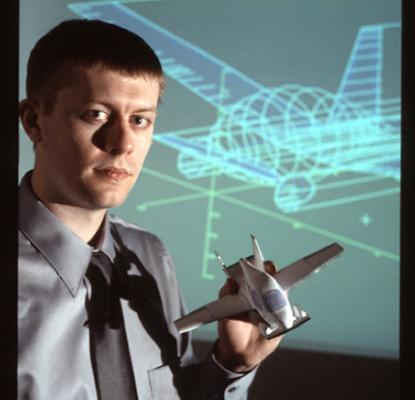Carl Dietrich
Carl Dietrich traces his earliest design innovations to elaborate spaceships he built from Fisher-Price® Construx building sets and tree forts in his parents' yard. He credits his father's penchant for model planes as the inspiration for his passion for aeronautics and aerospace. By the time he entered high school, Dietrich's inventive drive produced remote-controlled airplanes and designs for a hydrogen-powered aircraft.
Dietrich earned his SB (1999), SM (2003) and PhD (2006) in aeronautics and astronautics from MIT.
For his doctoral work, Dietrich researched inertial electrostatic confinement fusion for spacecraft power and propulsion under Dr. Raymond J. Sedwick, a principal research scientist at MIT's Space Systems Lab. This opportunity stemmed from an efficiency improvement design Dietrich patented for a desktop-sized Penning Fusion Reactor, following a research internship at Los Alamos National Laboratory in 2002. Dietrich credits this internship with sparking his initial curiosity about a distributed network of reactors that could potentially supplant the United States' strained power grid.
"MIT is so supportive," said Dietrich. As an undergraduate senior, he met with the head of MIT's aeronautics and astronautics department to present his idea to build a suborbital rocket engine. Afterward he was given $10,000 to build it. The challenging environment of MIT pushed Dietrich to work harder, which was more rewarding to him than doing things the easy way.
In 1998 Dietrich co-founded the MIT Rocket Team. He holds a patent for his Centrifugal Direct Injection Engine (CDIE)—a low-cost, high-performance rocket propulsion engine. CDIE operates without a conventional turbopump pressurization system, which greatly reduces its complexity and cost.
Dietrich also invented the PickProd—a blast-safe demining pick for safer removal of anti-personnel landmines in environments with hard-packed earth, such as Afghanistan. He deliberately did not patent his invention, so that it could be used by anyone in need.
In 2006 Dietrich and four MIT colleagues (and fellow pilots) launched a start-up company called Terrafugia to create the "Transition," a Personal Air Vehicle concept. The Transition is now in development at the company's facility in Woburn, Massachusetts. It will exploit the nation's thousands of underutilized public-access airports by providing a practical transportation alternative to travelers whose trips range between 100 and 500 miles. The vehicle can be driven on any surface road, requires only a sport pilot's license to fly, and operates on premium-unleaded gasoline. According to Dietrich, it's not a flying car; it's a roadable aircraft.
Dietrich's four patents pending for the Transition include: overall configuration, deformable aerodynamic bumpers, embedded lights and license plate holder, and an RFID system for rapid access to local airports.
In 2003 Dietrich was part of a team that received the $3000 International Technology Prize in the MIT IDEAS Competition. He was awarded the Gelb Fellowship in 2002 and the Sixteen XVI Award in 2002, which is presented to MIT Aero/Astro alumni under the age of 35 "for demonstrating extraordinary accomplishment early in their career."
"The best way to think of an invention, I think, is to think of a need," said Dietrich, a native of Sausalito, California. "Make every mistake that you can."
In April 2017, Dietrich left Terrafugia and sold his company to a chinese industrialist, Chao Jing.
And as of 2019, Dietrich continued his passion and love for aeronautics and aerospace and co-founded another company called Jump Aero Incorporated. Jump Aero Incorporated works with electric vertical takeoff and landing (eVTOL) aircraft technology to help first responders save lives.


